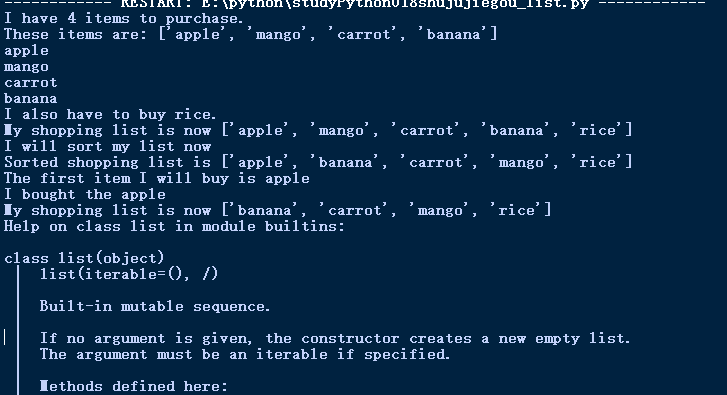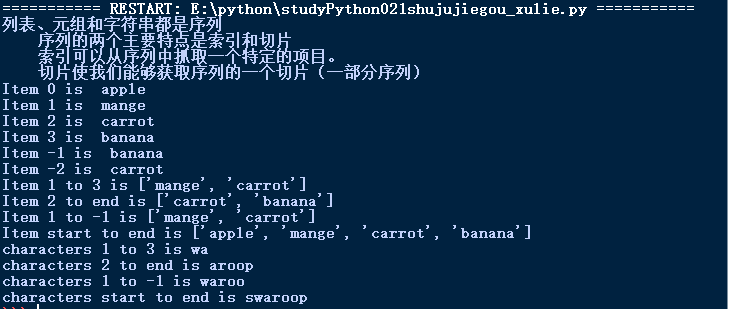简介
数据结构是处理数据的结构,或者说,他们是用来存储一组相关数据的。
在Python中三种内建的数据结构--列表、元组和字典。学会了使用它们会使编程变得的简单。
列表
list是处理一组有序的数据结构,即你可以在一个列表中存储一个序列的项目。在Python每个项目之间用逗号分隔。
列表中的项目应该包括在方括号中,所以列表是一个可变的数据类型。
使用列表
shoplist = ['apple','mango','carrot','banana'] print('I have',len(shoplist),'items to purchase.') print('These items are:',shoplist) for item in shoplist: print(item) print('I also have to buy rice.') shoplist.append('rice') print('My shopping list is now',shoplist) print('I will sort my list now') shoplist.sort() print('Sorted shopping list is',shoplist) print('The first item I will buy is',shoplist[0]) olditem = shoplist[0] del shoplist[0] print('I bought the',olditem) print('My shopping list is now',shoplist) print(help('list'))
运行效果

元组
tuple
元祖和列表十分类似,只不过元祖和字符串一样是不可变的。
元祖使用圆括号用逗号分隔项目
使用元组
zoo = ('wolf','elephant','penguin') print(type(zoo)) print('Number of animals in the zoo is',len(zoo)) new_zoo = ('monkey','dolphin',zoo) print('Number of animals in the new zoo is',len(new_zoo)) print('All animals in new zoo are',new_zoo) print('Animals brought from old zoo are',new_zoo[2]) print('Last animal brought from old zoo is',new_zoo[2][2]) print('==================================================') #元祖与打印语句 age = 22 name = 'Swaroop' #%d表示整数%s表示字符串 print('%s is %d years old'%(name,age)) print('Why is %s playing with that python?'%name)
运行结果

print语句可以使用跟着%符号的项目元组的字符串。这些字符串具备定制的功能。定制让输出满足某种特定的格式。定制可以是%s表示字符串或%d表示整数。元组必须按照相同顺序来定制。
字典
以键值对的方式存储数据,键必须是唯一的,记住字典中的键/值对是没有顺序的。如果你想要一个特定的顺序,那么你应该在使用前自己对它们排序。
只能使用不可变对象来作为字典的键。
字典d={key1:value1,key2:value2}
字典是dict类的实例/对象
使用字典
a={ 'Swaroop':'aaaaa', 'larry':'bbbbb', 'Mats':'ccccc' } print("Swaroop's value is %s" %a['Swaroop']) a['Qing'] = 'asdasd' print(a) del a['Mats'] for name ,value in a.items(): print('Contact %s at %s'%(name,value)) if 'larry' in a: print("larry's value is %s" %a['larry'])
运行结果

关键字参数与字典。
如果换一个角度看待你在函数中使用的关键字参数的话,你已经使用了字典了!只需想一下——你在函数定义的参数列表中使用的键/值对。当你在函数中使用变量的时候,它只不过是使用一个字典的键(这在编译器设计的术语中被称作 符号表 )。
序列
列表、元组和字符串都是序列,序列的两个主要特点是索引和切片,索引可以从序列中抓取一个特定的项目。
切片操作符使我们能够获取序列的一个切片(一部分序列)。
使用序列
#序列 '''列表、元组和字符串都是序列 序列的两个主要特点是索引和切片 索引可以从序列中抓取一个特定的项目。 切片使我们能够获取序列的一个切片(一部分序列)''' print(__doc__) shoplist = ['apple','mange','carrot','banana'] print('Item 0 is ',shoplist[0]) print('Item 1 is ',shoplist[1]) print('Item 2 is ',shoplist[2]) print('Item 3 is ',shoplist[3]) print('Item -1 is ',shoplist[-1]) print('Item -2 is ',shoplist[-2]) print('Item 1 to 3 is',shoplist[1:3]) print('Item 2 to end is',shoplist[2:]) print('Item 1 to -1 is',shoplist[1:-1]) print('Item start to end is',shoplist[:]) name = 'swaroop' print('characters 1 to 3 is',name[1:3]) print('characters 2 to end is',name[2:]) print('characters 1 to -1 is',name[1:-1]) print('characters start to end is',name[:])
运行结果

print()换行问题
print(item,end=' ')
end就表示print将如何结束,默认为end="\n"(换行),只要让end不使用默认值"\n",就能阻止它换行。
对象与类的快速入门
列表是使用对象和类的一个例子。当你使用变量给它赋值的时候,比如i=5,你可以认为你创建了一个类型为int的对象i。事实上可以通过help(int)更好的理解这个概念。